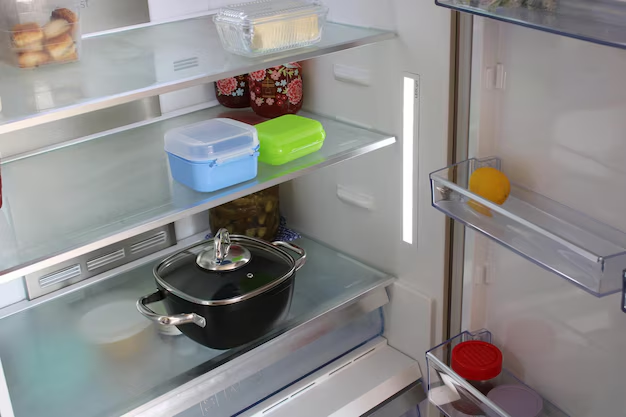A Cool Guide to Keeping Your Fridge Organized
Few things bring the same sense of satisfaction as opening your refrigerator door to find everything in its place, inviting and easy to access. Whether you frequently prepare home-cooked meals or simply want to keep your snacks orderly, a well-organized refrigerator can make all the difference. Organizing your refrigerator not only maximizes the freshness of your food but also saves you time and money by reducing waste. Let's dive deep into the art of refrigerator organization and explore how to keep it efficient and hassle-free.
🥶 Why Organize Your Refrigerator?
Before we jump into the nitty-gritty on how to organize your fridge, let's understand the benefits:
- Prolongs Freshness: Placing items in their ideal spots within the fridge can help keep them fresh longer.
- Reduces Waste: By knowing what you have and where it is, you prevent food from going bad and needing to be discarded.
- Saves Time: An organized fridge makes it quick and easy to find what you need, when you need it.
- Improves Efficiency: Better airflow through a well-organized space can help keep the consistent temperature, which enhances efficiency and energy usage.
Now, let's move step by step through the various techniques and insights needed to transform your fridge into a marvel of organization.
🚪 First Things First: Clean It Out
Start Fresh
Before organizing, you need a clean canvas:
- Empty the Fridge: Take everything out, including food items, shelves, and drawers.
- Clean Surfaces: Use a mild cleaning solution or warm soapy water to clean all surfaces inside the refrigerator.
- Check Expiry Dates: Review the expiration dates on items as you remove them and discard anything that's past its prime.
- Categorize: Group similar items together for easy placement when you return them to the fridge.
🗂️ How to Organize by Zones
Organizing your fridge by zones is optimal for maintaining freshness and ensuring ease of access. Here’s a breakdown:
Upper Shelves
Best for Ready-to-Eat Foods:
- Cooked dishes and leftovers belong here.
- Store foods in transparent containers for visibility.
Middle Shelves
Best for Dairy:
- Milk, yogurt, and cheese do well on these shelves where temperatures are most constant.
- If space allows, use bins to further categorize items.
Lower Shelves
Best for Raw Ingredients:
- Raw meat and fish should ideally be stored on the bottom shelf to prevent any risk of cross-contamination. Use leak-proof containers.
Crisper Drawers
Best for Fruits and Vegetables:
- Many refrigerators come with separate drawers for fruits and vegetables. Use one for each, as they require different humidity levels.
- Adjust the settings as necessary: Vegetables thrive in high-humidity drawers, while fruits prefer low-humidity settings.
Door Compartments
Best for Condiments:
- Stash your sauces, juices, and condiments here. Avoid storing highly perishable items like milk or eggs in the door, where temperatures fluctuate the most.
🔄 Useful Tips for Maintenance
Use Clear Storage Bins
These keep food products organized and visible, making it easier to track inventory. Assign each bin a theme—such as dairy, snacks, or condiments—to streamline retrieval.
Labels are Your Friend
Consider labeling bins or shelves to indicate what kinds of items belong in each space. This helps everyone in the household know where things go.
Implement the First-In, First-Out (FIFO) Method
Stock newer items behind older ones to ensure you're using foods before they spoil.
🥤 Efficient Use of Space
Stack Smartly
- Use both vertical and horizontal space creatively. Invest in stackable containers that allow you to utilize the full height of each shelf.
Lazy Susans are Handy
- A lazy Susan can help make awkward, hard-to-reach spaces more accessible, ensuring even the smaller jars aren't lost in the shuffle.
🤏 Best Practices for A Cooler and More Efficient Fridge
Keep It Cool
Setting your refrigerator to the right temperature (just below 40°F or around 4°C) is critical to keeping foods fresh and preventing harmful bacteria from growing.
Avoid Overcrowding
An overcrowded fridge obstructs airflow, which can lead to inconsistent temperature distribution.
Practical Summary of Tips
Here's a quick highlight of practical organization tips:
- 🗂️ Categorize items for quick retrieval.
- 🔍 Clear Bins provide visibility and structure.
- 🥡 Use FIFO to reduce waste.
- 🔄 Maintain proper airflow for optimal cooling.
- 🌐 Zone organization—utilizing each part of the fridge for its best purpose.
🚀 Moving Forward With an Organized Fridge
A well-organized refrigerator brings ease to your daily routine. With clear zones and practical storage solutions, you’ll never have to dig through heaps of food to find that elusive jar of pickles. Maintaining your organizational system is key, so make it a regular activity to realign your fridge and periodically reassess its contents.
With these strategies, your refrigerator will become a bastion of efficiency, catering effectively to your culinary and nutritional aspirations. Keep these insights in mind to preserve freshness, taste, and nutritional integrity, optimizing every mealtime preparation. Say goodbye to leftovers getting lost and ingredients expiring unnoticed—hello, refrigerator organization excellence!
